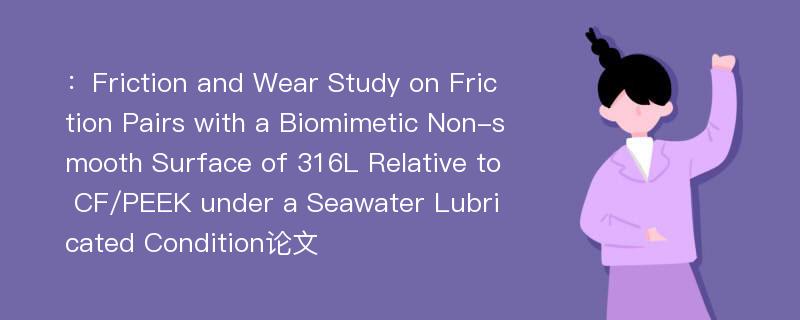
本文主要研究内容
作者(2019)在《Friction and Wear Study on Friction Pairs with a Biomimetic Non-smooth Surface of 316L Relative to CF/PEEK under a Seawater Lubricated Condition》一文中研究指出:Current studies of a seawater axial piston pump mainly solve the problems of corrosion and wear in a slipper pair by selecting materials with corrosion resistance, self-lubrication, and wear resistance. In addition, an appropriate biomimetic non-smooth surface design for the slipper pair can further improve the tribological behavior. In this paper, 316 L stainless steel and CF/PEEK were selected to process the upper and bottom specimens, and the biomimetic non-smooth surface was introduced into the interface between the friction pair. The friction and wear tests were performed on a MMD-5 A tester at a rotation speed of 1000 r/min and load of 200 N under seawater lubricated condition. The results indicate that the main friction form of the smooth surface friction pair corresponds to abrasive wear and adhesive wear and that it exhibits a friction coe cient of 0.05–0.07, a specimen temperature of 56 °C, a high wear rate, and surface roughness. Pits on the non-smooth surface friction pairs produced hydrodynamic lubrication and reduced abrasive wear, and thus the plowing e ect is their main friction form. The non-smooth surface friction pairs exhibit a friction coe cient of 0.03–0.04, a specimen temperature of 48 °C, a low wear rate, and surface roughness. The study has important theoretical significance for enriching the lubrication, friction, and wear theory of a seawater axial piston pump, and economic significance and military significance for promoting the marine development and the national defense military.
Abstract
Current studies of a seawater axial piston pump mainly solve the problems of corrosion and wear in a slipper pair by selecting materials with corrosion resistance, self-lubrication, and wear resistance. In addition, an appropriate biomimetic non-smooth surface design for the slipper pair can further improve the tribological behavior. In this paper, 316 L stainless steel and CF/PEEK were selected to process the upper and bottom specimens, and the biomimetic non-smooth surface was introduced into the interface between the friction pair. The friction and wear tests were performed on a MMD-5 A tester at a rotation speed of 1000 r/min and load of 200 N under seawater lubricated condition. The results indicate that the main friction form of the smooth surface friction pair corresponds to abrasive wear and adhesive wear and that it exhibits a friction coe cient of 0.05–0.07, a specimen temperature of 56 °C, a high wear rate, and surface roughness. Pits on the non-smooth surface friction pairs produced hydrodynamic lubrication and reduced abrasive wear, and thus the plowing e ect is their main friction form. The non-smooth surface friction pairs exhibit a friction coe cient of 0.03–0.04, a specimen temperature of 48 °C, a low wear rate, and surface roughness. The study has important theoretical significance for enriching the lubrication, friction, and wear theory of a seawater axial piston pump, and economic significance and military significance for promoting the marine development and the national defense military.
论文参考文献
论文详细介绍
论文作者分别是来自Chinese Journal of Mechanical Engineering的,发表于刊物Chinese Journal of Mechanical Engineering2019年04期论文,是一篇关于,Chinese Journal of Mechanical Engineering2019年04期论文的文章。本文可供学术参考使用,各位学者可以免费参考阅读下载,文章观点不代表本站观点,资料来自Chinese Journal of Mechanical Engineering2019年04期论文网站,若本站收录的文献无意侵犯了您的著作版权,请联系我们删除。
